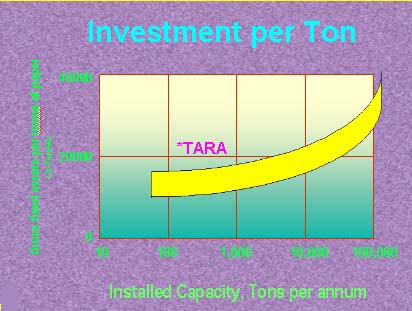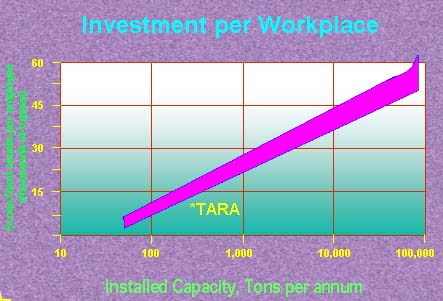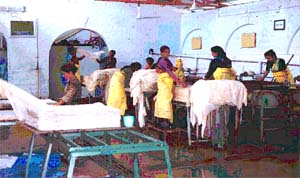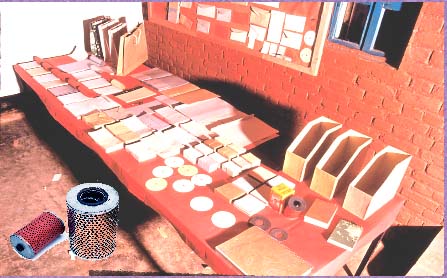|
Development of the Indian Handmade Paper Industry T.N. Subramanian & Dr Arun Kumar |
|
The Indian paper and board industry offers many opportunities for the innovative use of limited resources. For a developing country like India, faced with increasing shortages of raw materials, energy sources and capital, the development of the handmade paper industry offers considerable potential to meet the increasing demand for paper products in an environment-friendly way. Handmade paper production uses exclusively non-forest raw materials; it is particularly well suited to internal recycling; and it is not centralised in large-scale units. A case study is presented of the TARA handmade paper production unit in Delhi. The importance of both technology development and marketing initiatives is emphasized. |
Introduction
The demand for paper and board in India will certainly continue to grow as the country’s economy develops over the coming decades. Per capita consumption is expected to rise from the present 2.5 kg to 4 kg by the year 2000. This figure is still rather low compared with consumption per capita in many industrialized countries. Total production of paper and board in India is predicted to rise in the next six years from 2.2 million to 4 million tonnes.
Like other industries, paper production requires an assured supply of raw materials. Given the current pressure on forests, the wood-based resources traditionally used will become increasingly scarce and uneconomical. Their scarcity has already lead to a decline in capacity utilization in the Indian Paper industry. Paper and board mills are currently running at 60 per cent capacity. In recent years, 0.86 million tonnes of installed capacity has become redundant for various reasons including energy shortages and increasingly strict pollution control legislation.
Handmade paper units, on
the other hand, are mainly constrained only by limited demand. In a world
where the emphasis is clearly shifting to environment-friendly products and
production systems, the large untapped potential of the handmade paper
industry cannot be ignored. For a developing country like India, faced with
increasing shortages of natural raw materials, energy sources and capital, the
development of this industry offers considerable potential to meet development
objectives and respond to demand for both domestic and export products.
Potential and characteristics of hand-made paper production
Handmade paper units are defined essentially by the fact that their operations are carried out manually. with pure cellulosic (or raw) materials to be pulped, mechanical rather than chemical pulping methods would be used. In fact, the existing handmade paper industry relies wholly on secondary resources. There is no theoretical limit to the size of handmade paper units, though in India they are often limited in practice to a production capacity of 300 tonnes per year.
According to the Khadi & Village Industries commission, the combined production of 310 working handmade paper production units in India amounts to some 7000 tonnes per year. This sector produces goods valued at $2.5 million with a work force of 5300 persons.
The handmade paper industry uses exclusively non-forest raw materials. At present, it uses only cellulose-rich materials such as cotton rags, waste paper and waste kraft. This could easily be extended to the use of biomass materials and agricultural residues, some of which can be grown specifically for handmade paper production. Non-wood biomass resources have the additional advantage of being amendable to conversion by environment friendly processes. Some steps have already been initiated in this direction for the utilisation of straws, rice husk and grasses.
Handmade paper production also offers extensive possibilities for in-plant recycling. The paper waste emanating from industries incorporating intensive use of paper can very conveniently be recycled for reuse in the parent industry, often saving costs. Moreover, opportunities exist for interfacing paper recycling systems with a host of industries involved in, for example, packaging, printing, and industrial filter manufacture.
In its effort to develop effective systems for small-scale paper production, Development Alternatives has analysed the performance of the Indian paper industry on all scales. This analysis has drawn on industry publications and information concerning technology, trade and production obtained directly from operating units.
The Indian paper industry can be divided into four categories:
| i) | large-scale (integrated) units - 50,000 tonnes and up per year; |
| ii) | medium-scale units - 10,000 to 50,000 tonnes per year; |
| iii) | small-scale agro-based units - up to 10,000 tonnes per year; |
| iv) | handmade paper units - 60 to 300 tonnes per year. |
Our analysis indicates that specific consumption of resources is lowest in handmade paper units. Water consumption per tonne of paper is 150 cubic metres for handmade paper, compared with some 250 cubic metres for paper from large-scale integrated units. Large-scale integrated units also consume large quantities of electricity and chemicals, and are polluting, Small-scale agro-based units are severely polluting, as they are usually unable to afford pollution control equipment.
Large-scale units consume an average of 2.5 tonnes of forest-based raw materials per tonne of paper; small-scale units consume an average of 3.5 tonnes of raw materials, mostly agro-based, per tonne of paper. In contrast, a handmade paper unit uses only 1.1 tonne of paper produced. One important reason for this is that waste generated in the manufacturing process is internally recycled without loss of quantity.
Handmade paper
production does not require large-scale capital investment. Economically,
this is one of its biggest advantage in the Indian context. It is clear from
Figure 1 that capital intensity increases dramatically as the scale of
production increases. For large-scale integrated units it can cost up to US$
1000 to add each extra tonne of capacity. Adding capacity in handmade paper
units costs only about half as much. Handmade paper enjoys a similar
advantage in employment generating potential. Employment creation in a
handmade paper unit requires only one tenths the capital required in a
large-scale integrated unit.
Case Study : the TARA handmade paper production unit
TARA (Technology and
Action for Rural Advancement) is the technology
 marketing wing of Development
Alternatives. The strategy of the TARA handmade paper production unit of
Development Alternatives is based on:
marketing wing of Development
Alternatives. The strategy of the TARA handmade paper production unit of
Development Alternatives is based on:
i) identification of unique market segments;
ii) development of a complete technology package, including recycling, for handmade paper.
The TARA handmade paper unit was commissioned in 1991 in the peri-urban area of Delhi. It employs 35 women and seven men. The key functions of paper manufacturing are performed by women. The women operators have been given on-the-job training. Productivity in the unit has increased from one to 4.5 tonnes per month, operating with eight-hour shifts.
Encouraged by the economic success of this enterprise, TARA is setting up a 16 tonne per month unit at Jhansi, in Central India.
Marketing Strategy
Handmade paper production in India has been constrained by poor demand, which in turn has been limited because of poor marketing. Efforts by the Government and its main village industry agency, KVIC, to promote the handmade paper industry have focused on production of office stationery articles and the creation of domestic demand. This emphasis on domestic markets has led to the production primarily of paper and paper products which can, in fact, be manufactured more efficiently and economically by the large paper mills. This has made the hand-made paper industry appear uncompetitive.
This need not be the
case. Handmade paper has its own unique selling
 propositions (USP), and TARA
has demonstrated the possibility of increasing production capacity through
technology development. Only when market niches are properly designed,
however, can handmade paper become an economically viable product.
propositions (USP), and TARA
has demonstrated the possibility of increasing production capacity through
technology development. Only when market niches are properly designed,
however, can handmade paper become an economically viable product.
The handmade paper unit commenced production by committing a major share of its output to industrial users. TARA was able to develop a high-quality black filter paper for India’s leading automotive filter manufacturer. The aim was to produce chemical-free paper which had the correct strength characteristics to replace the aluminium end discs of the filter. Other automotive filter manufacturers catering to the replacement market have followed suit. TARA was also able to develop a high quality, zero-net-waste recycling system in which the waste generated during manufacture of sub-components is recycled. The flow chart and details of the recycling system are shown in Figure 3.
More recently, TARA has
developed over 100 varieties of handmade paper using a wide choice of waste
paper, rags, natural biomass mixtures, and agro-residues.
Process development
Due to the flexibility of its manufacturing process, the TARA unit is able to devise the blend of materials and recipes for manufacturing handmade paper according to client needs and specifications. Through this exercise, a large selection of papers of natural grades and shades (i.e. produced without chemical bleaching) has been developed using a variety of biomass materials such as straws, grasses and silk cotton. This has been achieved with minimum use of chemicals and through mechanical pulping. Each variety of paper is specified according to the process parameters to be controlled, which include pulp characteristics, and control of surface finish.
Another important aspect
of process development is the internal recycling
 of resources, especially
water. In a proposed scheme (Figure 4), water from intermediate processes
such as pressing will be collected and reused in other operations. The
targeted consumption of water in proposed TARA units is 90 cubic metres per
tonne of paper produced, compared with the existing level of 150 cubic metres.
of resources, especially
water. In a proposed scheme (Figure 4), water from intermediate processes
such as pressing will be collected and reused in other operations. The
targeted consumption of water in proposed TARA units is 90 cubic metres per
tonne of paper produced, compared with the existing level of 150 cubic metres.
Equipment
development
The standard equipment
available for handmade paper production was found to b inadequate, both in
terms of performance and reliability. The equipment development under-taken
by Development Alternatives has resulted in higher productivity.
Quality control procedures
Handmade paper will gain
widespread acceptance only if it can be produced and delivered with a high
level of consistency of quality and reproducibility between different lots.
Quality control is an even bigger problem for the handmade sector than for the
rest of the paper industry. Quality control procedures have largely been
ignored, leading to poor realization and a very high level of rejection. the
quality control procedures evolved by TARA lay down specifications for the
purchase of raw materials, inspection procedures, and control of pulp
parameters. Acceptance procedures for pulp can ensure that the paper produced
will be suitable for down line processes up to the finishing stage.
Future area of research
The handmade paper
industry can flourish by adding new capacity, by
 rejuvenation of existing
units through technology inputs, and by development of specific market
segments. However, the sustained growth of handmade paper units will require
further research in several key areas:
rejuvenation of existing
units through technology inputs, and by development of specific market
segments. However, the sustained growth of handmade paper units will require
further research in several key areas:
Raw materials
Handmade paper
production currently hinges on the availability of cotton rags and waste
paper. Many other materials currently used only for blending could form a
major component in the manufacture of paper. Materials identified for active
research are silk cotton (a type of tree cotton), banana fibre, straws and
grasses. These materials can easily be cultivated locally for paper
production.
Environment-friendly processes
The use of diverse materials will depend on the development of environment-friendly processes. One area of research will be the use of biotechnology, for example for the recovery of alpha-cellulose from different non-forest based materials, and for lignin removal using organisms like white-rot fungi. The use of chemicals, and associated effluent disposal problems, could be avoided through use of bio-technological processes for digestion.
Another area of research
is the recovery of natural dyes for paper and printing links. The use of
natural dyes can increase the choice of colours, textures and finishes,
besides leading to the creation of jobs involving, for example, block
printing.
Skill development
Handmade paper
production requires close controls on thickness and weight, both of which have
traditionally depended on exceptional operator skills. Technology development
will need to integrate methods for rapid skill development as a means of
internal quality control.
Recycling partnership
There is a large,
unexplored wealth of waste cellulose materials and paper waste emanating from
different industries. Although systems exist for the recovery and recycling
of major wastes, higher value addition can be achieved by internal recycling
in the industries generating the waste. This will require the creation of
partnerships for integrating recycling technology with social objectives in an
economically viable manner. Such partnerships need to be researched, and
their wide-scale acceptance amongst existing industries promoted.
Innovation production systems
Handmade paper
production is amenable to decentralization. Through research, units based
exclusively on local production of non-forest based raw materials can be
planned. Future small, decentralized units can easily be installed in rural
areas, even areas with limited access to water and electricity. The part of
the production system that requires major capital investments, and may thus
benefit from economies of scale, could be based in urban areas and integrated
with the marketing system.
Conclusions
The case study of the TARA handmade paper unit demonstrates the importance of technology development in tandem with the development of markets. Such effort have a potential to be widely replicated in a sustainable manner in decentralized production units. Further research is needed in key areas such as technology (including that required for recycling), the training of employees, and marketing. q
References
1. See N.J. Rao, Quarterly Journal of Indian Pulp and Paper Association, 1993, pp. 1-11.
2. See R.S. Gora, K.L. Shah and P.K. chakravarty, Quarterly Journal of Indian Pulp and Paper Association Vol. 3 (4), 1993, pp.44-49.
The article was first published in the UNEP quarterly ‘Industry and Environment’ Vol. 17, No. 2, April-June, 1994.
|
||||||||||||||||
| Donation | Home | Contact Us | About Us |